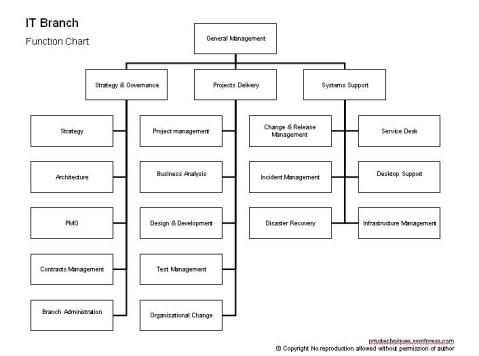IT Branch – Function Chart
IT Branch – Function Chart
Introduction
The IT Branch – Function Chart is a hybrid function and organisational chart to explain the key functions of an IT Branch of a organisation with a total of 1000-5000 employees. I would suggest that each of these functions is filled with an ‘manager’ who may have a number of people working in the function.
The PMOBK, PRINCE2 and ITIL methodologies feature somewhat in this chart. The structure doesn’t employ either of these methodologies completely.
Diagram:
Strategy & Governance – Function Descriptions
|
Function
|
Brief Description
|
|
General Management
|
Operational management of a business unit that delivers specialist technology services to an organisation.
|
|
Strategy
|
Help the business deliver on its objectives, business strategies and goals by aligning business and IT.
Develop and maintain and IT systems strategy and direct IT investments in line with business and IT strategies.
|
|
Architecture
|
Develop and maintain enterprise architecture strategies and standards.
Provide specialist advice and review projects to ensure compliance and integration with enterprise architecture.
|
|
PMO
|
Owner of the branch project management methodology including processes and templates. Develop and maintain project management tools, methods, procedures and equipment.
Provides project controls function across portfolio in relation to quality, time or cost risks to projects.
|
|
Contracts management
|
Manage IT supplier relationships and monitor commercial, contractual, legal and financial outcomes against contract and contract Key Performance Indicators.
Ensure the organisation achieves maximum value from IT supplier arrangements.
|
|
Business Administration
|
Provide administration services to the branch including purchasing, bookkeeping and office management.
|
Project Delivery – Function Descriptions
|
Function
|
Brief Description
|
|
Project Delivery
(Program Management)
|
Program management ensures the effective delivery of multiple, simultaneous projects.
Ensure all projects are successfully monitored, documented, tracked, reported, integrated and implemented.
|
|
Project Management
|
Manage the end-to-end delivery of projects to deliver quality outcomes for business owners.
Application of Project Management competencies including scope, time, costs, quality, HR, communications, risk, procurement, and integration management.
|
|
Business Analysis
|
Business Analysts work with and on behalf of business owners to ensure that business and user requirements are delivered in IT solutions.
Business analysis may include process/scenario analysis or process re-engineering, documentation of business requirements for IT systems and project management of activity within projects.
|
|
Design and Development
|
Designing, developing, system testing and maintenance of applications software to meet users requirements and compliance to enterprise architecture standards.
|
|
Test Management
|
Planning and execution of scenario or functional based testing of applications to ensure stability, reliability of production applications.
|
|
Organisational Change
|
Supports the business throughout the project implementation period. Activities include change impact analysis, change planning and implementation activities such as road-shows, training and communication.
|
Systems Support – Function Descriptions
|
Function
|
Brief Description
|
|
Systems Support
(Systems Support Manager)
|
Systems support ensures the operation of systems to support the business as agreed in Service Level Agreements with the business.
Systems support management incorporates a wide range of activity and is well defined by ITIL (Information Technology Infrastructure Library)
|
|
Change & Release Management
|
The change management function ensures minor changes to infrastructure and application or configuration/data changes follow process and are managed effectively.
The release management function ensures major releases have followed process. Release management is a key quality point for major implementations.
|
|
Incident Management
|
Ensure procedures and processes are in place to deal with high impact incidents that impact Service Level Agreements. Manage incidents through to return to SLA, raise Problems as potential projects to delivery group.
|
|
Disaster Recovery
|
Developing, planning, testing and administering the organisation’s Disaster Recovery plans and procedures.
|
|
Service Desk
|
The Service Desk provides first level support to all users of IT systems and incident trend reporting to the IT branch.
|
|
Desktop Support
|
Provides Desktop support services to the organisation including desktop lifecycle management and Standard Operating Environment release management.
|
|
Infrastructure Support
|
Infrastructure support provides enterprise level infrastructure services including Email services, messaging systems (EAI), financials infrastructure and other hardware, database and facility management services.
|
